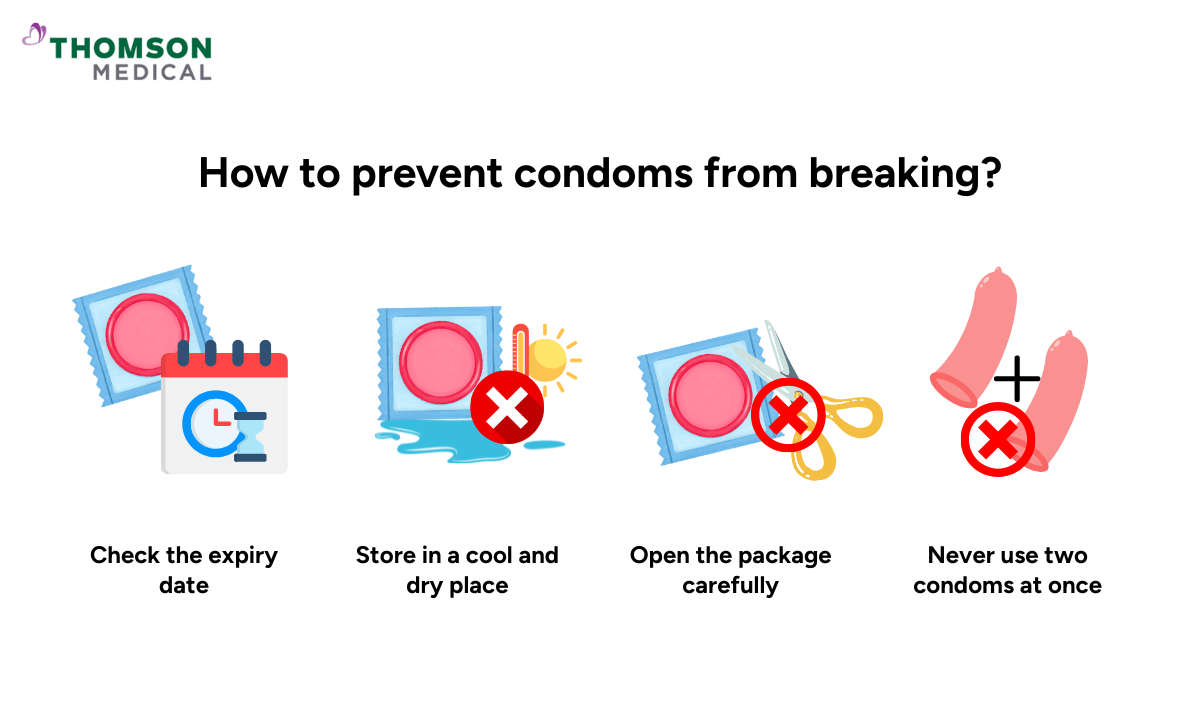Even when you do everything right, accidents can still happen, including a condom breaking during intercourse. It can be upsetting, especially if you’re not sure what to do next. The important thing is not to panic. Condom breakage happens more often than people think, and there are clear steps you can take to protect yourself and your partner.
Whether you’re worried about pregnancy, sexually transmitted infections (STIs), or just want to be prepared, it helps to know what to do next. Taking the right steps can keep you safe and give you peace of mind.
What to do if the condom breaks?

A broken condom can feel worrying, but it’s something many people experience at some point. When a condom breaks, there’s also a small chance of exposure to sexually transmitted infections (STIs), sometimes referred to as sexually transmitted diseases (STDs), especially if there was contact with bodily fluid (semen or vaginal fluids). Taking action quickly can help lower that risk.
How to check if the condom broke
If you think the condom might have broken, stop and check right away. You can usually spot a break or tear by looking for these signs:
The condom feels looser or slips off during intercourse
You feel a sudden snap or tear
There is more skin contact or extra moisture than usual
After intercourse, you see a tear, hole, or semen leakage around the condom
To double-check, you can fill the condom with water and squeeze gently to see if any leaks appear. If you find even a small tear, assume it broke.
Things to consider
Once you realise the condom may have broken, pause and check the situation. This helps you decide what to do next calmly. Ask yourself:
Did the condom break after ejaculation?
If no semen was released, you can remove the broken condom, put on a new one, and continue once you are ready.
Is the condom still in place?
If it has slipped off, remove it gently from you or your partner as soon as possible.
Could pregnancy be a possibility?
If there’s a chance of pregnancy, consider using emergency contraception as soon as you can.
Could there be a risk of STI transmission?
If you or your partner aren’t sure about your STI status, get tested. In some cases, medicines can lower the risk of infection.
If you’re concerned about pregnancy
When a condom breaks, emergency contraception (EC) can help prevent pregnancy. These methods are most effective the sooner you use them, ideally within a few days after intercourse.
Emergency Contraception
There are two main types of emergency contraception:
Hormonal pills can delay or stop the release of an egg (the time when a woman can get pregnant). Levonorgestrel and Ulipristal acetate are two kinds of these pills. Levonorgestrel pills are effective for up to 3 days after intercourse, while ulipristal acetate can be taken up to 5 days. Both work best when taken as soon as possible.
The copper IUD (non-hormonal coil) can be inserted within 5 days after intercourse, or up to 5 days after the earliest possible ovulation. It works by stopping the sperm and egg from meeting. The copper IUD can also provide long-term contraception for 5-10 years, depending on the type.
You can choose between an emergency contraception pill (morning-after pill) or a non-hormonal coil, depending on what suits you best.
When to take a pregnancy test
For the most reliable result, take a pregnancy test around 21 days after intercourse or the day your period is due. Taking it too early might give a false negative. If your period doesn’t start, retest after a few days. Use your first urine of the morning for the most accurate result.
If your test is positive or you’re uncertain about the result, contact your doctor for confirmation and advice on next steps.
Our specialist
Loading...
If you’re concerned about STI transmission
Condoms protect against most STIs, but a break can expose you to risk. If this happens, it’s important to know what to do next.
Preventive medication
If you’re at risk of HIV or other bacterial STIs, preventive medication can help reduce infection.
Doxycycline Post-Exposure Prophylaxis (Doxy-PEP) involves taking doxycycline within 72 hours after unprotected intercourse. It can lower the risk of chlamydia and syphilis, though evidence for gonorrhoea is less certain. It’s mainly recommended for people at higher risk, such as those with multiple partners or a recent STI history.
Doxy-PEP should only be used under medical supervision. It’s not a substitute for condoms and should be part of a broader sexual health plan.
If you suspect HIV exposure, ask a healthcare provider about Post-Exposure Prophylaxis (PEP). PEP must start within 72 hours and continue for 28 days to be effective.
When to get an STI test
If a condom breaks, get tested for STIs as soon as possible, even if you don’t have symptoms. If you have a new partner or engage in unprotected intercourse, it’s wise to get tested around 3 weeks after exposure and again at 3 months.If you have multiple partners or frequent unprotected intercourse, regular screening every 3 to 6 months is recommended.
STI symptoms to watch out for
Some STIs don’t show any signs, so routine testing is important. However, watch for STIs symptoms such as:
Unusual discharge
Pain or burning when urinating
Sores, blisters, or rashes on genitals, anus, or mouth
Itching, pelvic pain, or pain during intercourse
Flu-like symptoms such as fever and body aches
If you’ve recently had unprotected intercourse, a new partner, or are noticing any of these symptoms, don’t wait to get tested. Request an appointment with Thomson Medical to schedule an STI screening. Our specialists provide confidential testing, clear explanations of your results, and personalised guidance for your sexual health.
How to prevent condoms from breaking?

Condoms are reliable when used correctly. To avoid breakage:
Check the expiry date and ensure the package isn’t damaged
Store condoms in a cool and dry place
Open the package carefully
Use the right size
Use water-based or silicone-based lubricant
Never use two condoms at once
Always use a new condom for each act of intercourse
Using condoms correctly lowers the risk of breakage and protects against STIs and pregnancy.
If you want personalised guidance on safe intercourse, proper condom use, and choosing the right protection for you and your partner, request an appointment with Thomson Medical to consult our sexual health specialists.
FAQ
What are the chances of getting pregnant if the condom breaks?
The risk depends on whether there was ejaculation, timing in your cycle, and how quickly you use emergency contraception. The chance is highest if intercourse occurs during the fertile window (the days in a woman’s cycle when an egg is available for fertilisation), around ovulation.
Should I panic if the condom broke?
No, you should not panic if the condom breaks, as this happen occasionally. Stay calm, stop immediately, check for damage, and consider emergency contraception or STI testing as soon as possible.
How can I prevent pregnancy after a condom breaks?
To prevent pregnancy after a condom breaks, you should use emergency contraception as soon as possible. You can take Levonorgestrel within 3 days or ulipristal within 5 days, or have a copper IUD inserted within 5 days for the most effective protection.
When should I get tested after a condom breaks?
If a condom breaks, testing for most STIs is reliable 2-3 weeks after exposure. You should also be re-tested after 3 months to confirm a negative result. If HIV is possible, start PEP (post-exposure prophylaxis) within 72 hours.
Do you need PrEP if a condom breaks?
No, you do not need PrEP if a condom breaks. PrEP (pre-exposure prophylaxis) is taken daily to prevent HIV before exposure. If a condom breaks and you're concerned about HIV exposure, you need PEP (post-exposure prophylaxis) instead, which should be started within 72 hours and continuing for 28 days.
What precautions should I take if a condom breaks?
If a condom breaks during intercourse, you should stop right away, withdraw carefully, and replace the condom if continuing. Afterwards, consider using emergency contraception to prevent pregnancy, schedule STI testing, and consult a healthcare provider about PEP if there's a risk of HIV exposure. It's advisable to visit a sexual health clinic for personalised advice on your next steps.
The information provided is intended for general guidance only and should not be considered medical advice. For personalised recommendations and tailored advice based on your unique situations, please consult a specialist at Thomson Medical. Request an appointment with Thomson Medical today.
For more information, contact us:
Thomson Specialists (Women's Health)
Thomson Women's Clinic (TWC)
- Novena:
6592 6686 (Call), 8611 8986 (WA) - Bukit Batok:
6569 0668 (Call), 8686 3525 (WA) - Choa Chu Kang:
6893 1227 (Call), 8282 1796 (WA) Jurong:
6262 8588 (Call), 6262 8588 (WA)- Katong (female doctor):
6970 2272 (Call), 8611 9020 (WA) - Punggol:
6243 6843 (Call), 8811 0328 (WA) - Sembawang: 6753 5228
- Sengkang: 6388 8125
- Serangoon (female doctor): 6382 3313
- Tampines: 6857 6266
- Tiong Bahru: 6276 1525
